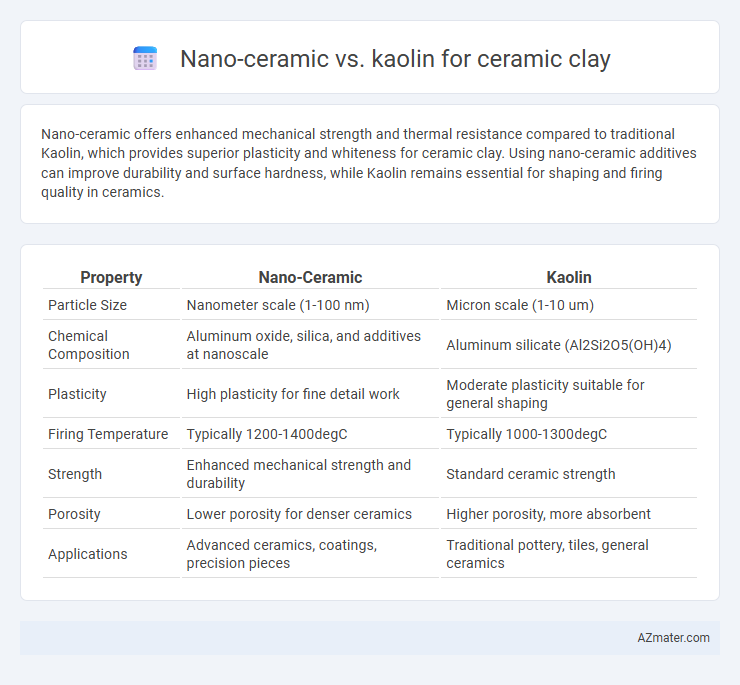Nano-ceramic offers enhanced mechanical strength and thermal resistance compared to traditional Kaolin, which provides superior plasticity and whiteness for ceramic clay. Using nano-ceramic additives can improve durability and surface hardness, while Kaolin remains essential for shaping and firing quality in ceramics.
Table of Comparison
| Property | Nano-Ceramic | Kaolin |
|---|---|---|
| Particle Size | Nanometer scale (1-100 nm) | Micron scale (1-10 um) |
| Chemical Composition | Aluminum oxide, silica, and additives at nanoscale | Aluminum silicate (Al2Si2O5(OH)4) |
| Plasticity | High plasticity for fine detail work | Moderate plasticity suitable for general shaping |
| Firing Temperature | Typically 1200-1400degC | Typically 1000-1300degC |
| Strength | Enhanced mechanical strength and durability | Standard ceramic strength |
| Porosity | Lower porosity for denser ceramics | Higher porosity, more absorbent |
| Applications | Advanced ceramics, coatings, precision pieces | Traditional pottery, tiles, general ceramics |
Understanding Nano-Ceramics: Definition and Composition
Nano-ceramics consist of ceramic materials engineered at the nanometer scale, typically below 100 nanometers, which enhances their mechanical strength, thermal stability, and chemical resistance compared to traditional ceramic clays like kaolin. Kaolin, a naturally occurring clay mineral rich in alumina and silica, serves as a primary raw material in ceramic production but lacks the nanoscale structural modifications that improve performance. Understanding nano-ceramics involves analyzing their composition of ultra-fine particles that create a denser, more homogeneous microstructure, enabling superior properties in advanced ceramic applications.
What is Kaolin? Origins and Properties
Kaolin is a naturally occurring clay mineral composed primarily of the mineral kaolinite, characterized by its fine particle size, white color, and high purity. Originating from the weathering of aluminum silicate minerals, kaolin deposits are commonly found in regions like China, the United States, and the United Kingdom. Its properties include excellent plasticity, high refractory capacity, and resistance to chemical attack, making it a fundamental component in traditional ceramic clay formulations and porcelain production.
Comparing Particle Structures: Nano-Ceramics vs Kaolin
Nano-ceramics feature ultra-fine particles, often less than 100 nanometers, which create a denser and more uniform microstructure compared to kaolin's larger and more irregular particle shapes. Kaolin particles typically range from 1 to 10 micrometers, contributing to its characteristic plasticity and workability but resulting in a coarser ceramic texture. The finer particle size of nano-ceramics enhances sintering efficiency, mechanical strength, and surface smoothness, making them superior in applications requiring high precision and durability.
Mechanical Strength and Durability Differences
Nano-ceramic clay exhibits superior mechanical strength compared to kaolin due to its finer particle size, which enhances bonding and reduces microfractures during firing. The nanostructure also provides greater durability by improving resistance to thermal shock and wear, making it ideal for high-performance ceramic applications. In contrast, kaolin, while valued for its plasticity and whiteness, tends to be less resilient under mechanical stress and has lower thermal stability than nano-ceramic composites.
Thermal Stability and Heat Resistance
Nano-ceramic clay exhibits superior thermal stability and heat resistance compared to kaolin due to its fine particle size and enhanced sintering properties, allowing it to withstand higher temperatures without deformation. Kaolin, while widely used in traditional ceramic production, has a lower thermal threshold and tends to break down or lose structural integrity at elevated temperatures. The incorporation of nano-ceramics in ceramic clay formulations improves durability and performance in high-temperature applications such as kiln linings and advanced engineering ceramics.
Impact on Workability and Molding Techniques
Nano-ceramic additives significantly enhance the workability of ceramic clay by improving plasticity and reducing drying shrinkage, which allows for finer detail retention during molding. Kaolin, a traditional clay mineral, contributes to ceramic strength and whiteness but may reduce plasticity, requiring more water and careful handling to prevent cracking during shaping and drying. The selection between nano-ceramic and kaolin impacts molding techniques, where nano-ceramics favor precision and complex designs, while kaolin is better suited for traditional hand-building and wheel-throwing methods.
Firing Temperatures: Nano-Ceramic vs Kaolin Clays
Nano-ceramic clays typically exhibit higher firing temperatures, often ranging between 1200degC to 1400degC, providing increased durability and strength in finished ceramics. In contrast, kaolin clays generally fire at lower temperatures around 1000degC to 1300degC, suitable for porcelain and fine china due to their white firing characteristics. The enhanced thermal stability of nano-ceramic clays makes them ideal for advanced applications requiring superior mechanical properties and resistance to thermal shock.
Surface Finish and Aesthetic Outcomes
Nano-ceramic clay offers a smoother surface finish and enhanced aesthetic outcomes due to its ultrafine particle size, which allows for more uniform glazing and finer detail retention. Kaolin clay, while providing excellent plasticity and whiteness, tends to have a coarser texture that can result in a less refined surface and slightly rougher finish after firing. The choice between nano-ceramic and kaolin primarily impacts the final visual quality and tactile smoothness of ceramic pieces, with nano-ceramic preferred for high-precision and glossy finishes.
Environmental and Health Considerations
Nano-ceramic clays typically contain ultrafine particles that may pose inhalation risks requiring proper ventilation and protective equipment to minimize respiratory exposure, whereas kaolin, a naturally occurring clay mineral, is generally considered safer with lower toxicity but can still cause silicosis if inhaled in large amounts. Environmentally, nano-ceramics may involve more intensive manufacturing processes with potential nanoparticle release concerns, while kaolin mining impacts include land disruption and water usage but fewer nanoparticle-related hazards. Both materials necessitate responsible handling and disposal practices to mitigate environmental contamination and protect worker health in ceramic production.
Cost-Effectiveness and Application Suitability
Nano-ceramic clay offers superior durability and a finer finish, making it ideal for high-quality ceramic products, though it generally incurs higher material costs compared to kaolin. Kaolin clay remains a cost-effective option due to its widespread availability and ease of shaping, suitable for mass production and traditional ceramics. Evaluating application suitability depends on balancing desired product properties with budget constraints, where nano-ceramics serve premium markets and kaolin supports broader industrial use.

Infographic: Nano-ceramic vs Kaolin for Ceramic clay
 azmater.com
azmater.com